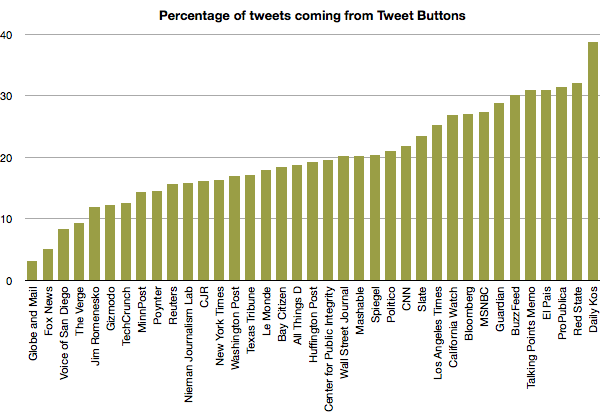Information Architects | Nieman Lab | Dan Zarrella
This week’s bit of status quo under question is the pervasiveness of “tweet,” “like” and other social-sharing buttons. Designer Oliver Reichenstein started the conversation with a passionate-but-unscientific essay arguing social buttons on your website make you look “a little desperate.”
In a medium full of advertisement and self-promotion, every unnecessary pixel of noise and ‘click-me!’-begging should be avoided if it can be. The less noise, the less begging, the less secondary advertisement means the easier it is to focus, and the more likely it is that people will actually read your content.
… Excellent content, serious networking and constant human engagement is the way to build your profile. Adding those sleazy buttons won’t achieve anything. Social media is not easy — there is no simple trick.
Reichenstein concedes that “some people probably do use those buttons. Maybe even a lot of people. … Maybe someone needs to do some serious research to know for sure.” Enter Joshua Benton, who ran some numbers to see how many of the tweets linking to a given news site originate from a tweet button. Most fall between about 15 percent and 30 percent, with some outliers.

Benton concludes that “this quick look would seem to support the idea that killing off Tweet Buttons would, for most news organizations, remove somewhere around 20 percent of their Twitter link mentions. … Or maybe less, since some percentage of those Tweet Button users would still find other means to tweet without them.”
And that, actually, is preferable, Reichenstein says: “If you provide excellent content, social media users will take the time to read and talk about it in their networks. That’s what you really want. You don’t want a cheap thumbs up, you want your readers to talk about your content with their own voice.”
There’s more to this story
One argument in favor of sharing buttons is the psychological phenomenon of “social proof,” where a person entering a new environment tends to conform to the behavior demonstrated by others. How does that apply? The tally of previous shares on a given article could offer social proof to the next reader that it is indeed worth reading and sharing — “just look at all these other people who already have!”
But in this case, social proof is not the only force at work. We also know that many people share content because it makes them look smart and well-informed. Part of that is being among the first to have shared it, and thus not sharing something that’s already well-circulated. In this way, a sharing button could limit the potential spread of your best content.
Reichenstein gets near this problem in his diagnosis:
If you’re unknown, social media buttons make you look like a dog waiting for the crumbs from the table. … That button that says “2 retweets” will be read as: “This is not so great, but please read it anyway? Please?”
If you’re known and your text is not that great the sleaze buttons can look greedy and unfair (yes, people are jealous). “1280 retweets and you want more?—Meh, I think you got enough attention for this piece of junk.”
Dan Zarrella has explored this tension between the opposing factors of novelty and social proof.
Some other related observations:
- “I personally copy and share the links the old way by pasting them to the social network that I feel is most relevant. When I do try and use social sharing buttons I often need to edit the text anyway as the links are not shortened or the message is not to my liking.” — Simply Zesty
- “We removed FB buttons and traffic from Facebook increased. Reason: instead of ‘liking’ articles, readers share it on their timeline.” — Smashing Magazine
- “A few months ago I toyed around with the idea of removing share buttons from my company’s email newsletters, just to see what would happen. … After a few email newsletters had gone out I checked out the numbers and was pleasantly surprised by what I saw—the blog posts were getting more shares than they had ever gotten before! I realized that the social share buttons in the newsletter weren’t doing me that much good.” — Search Engine Journal
Related: Those sharing buttons gather valuable data for the networks and providers (Forbes) | 15% of Americans now use Twitter, 8% use it daily (Poynter) || Earlier: Limited use of sharing buttons, as most people copy and paste links (Poynter)






Comments